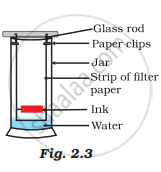Advertisements
Advertisements
प्रश्न
Calculate the mass of sodium sulphate required to prepare its 20% (mass percent) solution in 100g of water?
उत्तर
Let the mass of sodium Sulphate required to be = x g
The mass of solution would be = (x + 100) g x g of solute in (x + 100) g of solution
20% = `"x"/("x" + 100) xx 100`
20x + 2000 = 100x
80x = 2000
x = `200/80`
= 25g
APPEARS IN
संबंधित प्रश्न
A sample of drinking water was found to be severely contaminated with chloroform, CHCl3, supposed to be carcinogenic in nature. The level of contamination was 15 ppm (by mass).
- Express this in percent by mass.
- Determine the molality of chloroform in the water sample.
Solve the following problem:
Write the following number in ordinary decimal form:
5.16 × 104
Solve the following problem:
Write the following number in ordinary decimal form:
14.3 × 10−2
Solve the following problem:
Write the following number in ordinary decimal form:
0.00477 × 105
Solve the following problem:
Perform the following calculation. Round off your answer to two digits.
`((4xx10^-3)(9.9xx10^-7))/((789)(1.002xx10^-10)(0.3xx10^2))`
Solve the following problem:
Your laboratory partner was given the task of measuring the length of a box (approx 5 in) as accurately as possible, using a metre stick graduated in milimeters. He supplied you with the following measurements:
12.65 cm, 12.6 cm, 12.65 cm, 12.655 cm, 126.55 mm, 12 cm.
State which of the measurements you would accept, giving the reason.
Solve the following problem:
What weight of calcium oxide will be formed on heating 19.3 g of calcium carbonate?
(At. wt.: Ca = 40; C = 12; O = 16)
A child wanted to separate the mixture of dyes constituting a sample of ink. He marked a line by the ink on the filter paper and placed the filter paper in a glass containing water as shown in Fig.2.3. The filter paper was removed when the water moved near the top of the filter paper.
(i) What would you expect to see, if the ink contains three different coloured components?
(ii) Name the technique used by the child.
(iii) Suggest one more application of this technique.

Which of the following solutions have the same concentration?
(i) \[\ce{20 g of NaOH in 200 mL of solution}\]
(ii) \[\ce{0.5 mol of KCl in 200 mL of solution}\]
(iii) \[\ce{40 g of NaOH in 100 mL of solution}\]
(iv) \[\ce{20 g of KOH in 200 mL of solution}\]
What quantity (in mL) of a 45% acid solution of a monoprotic strong acid must be mixed with a 20% solution of the same acid to produce 800 mL of a 29.875% acid solution?
